
When you purchase through links on our site, we may earn an affiliate commission. Here’s how it works.

Tab is short for tablature, a notational system used to give detailed information as to where notes should be played on the fretboard.
Tab appears underneath conventional music notation as six horizontal lines that represent the strings of the guitar, from the sixth (thick) string at the bottom to the first (thin) string at the top.
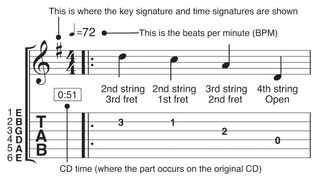
On these lines, numbers represent the frets where you should place your fingers. For example, an A note on the 2nd fret, third string, will be shown as a number ‘2’ on the third line down on the tab. Unfretted strings are shown with a ‘0’.
The key and time signatures are shown in the traditional notation. A timestamp may also tell you where in the original track you’ll find each example. Finally, a tempo marking is expressed in beats per minute.
Once you've got the hang of reading tab, why not try learning a few open-position guitar chords?
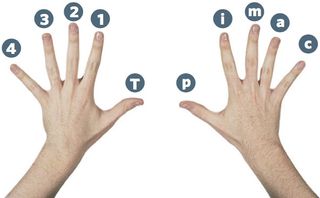
Here are the abbreviations used for each finger. Fretting hand: 1, 2, 3, 4, (T)
Picking hand: p (thumb), i (index), m (middle), a (annular), c (little finger)
Want all the hottest music and gear news, reviews, deals, features and more, direct to your inbox? Sign up here.
By submitting your information you agree to the Terms & Conditions and Privacy Policy and are aged 16 or over.
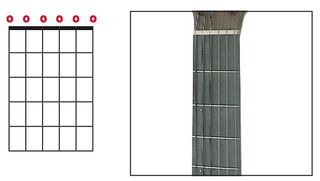
This fretbox diagram represents the guitar’s fretboard exactly, as seen in the photo. This design is used for ease of visualising a fretboard scale or chord quickly.
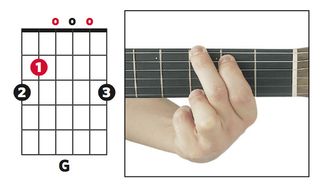
This diagram represents a G chord. The ‘o’s are open strings, and a circled number is a fretting hand finger. A black ‘o’ or circled number is the root note (here, G).
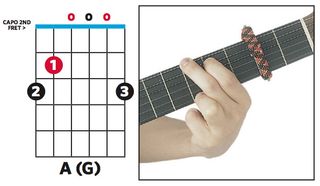
The blue line in the diagram represents a capo - for this A chord, place it at the 2nd fret. Capos change the fret number ordering. Here, the original 5th fret now becomes the 3rd fret, 7th fret now 5th fret, etc.
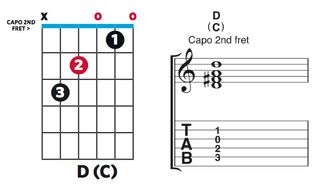
Here, the chord looks like a C in the tab, but the capo on the 2nd fret raises the pitch to make it a D. The 2nd fret capo’d notes are shown with a ‘0’ in the tab as if they were open strings.
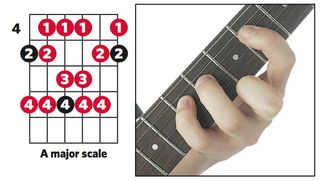
The fret box diagram illustrates the fret hand fingering for the A major scale using black dots for root notes and red dots for other scale tones. The photo shows part of the scale being played on the fourth string with the first, third and fourth fingers.
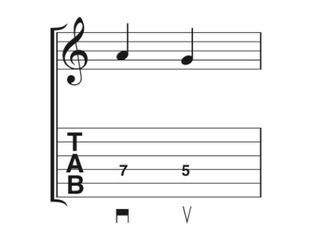
The symbols under the tab tell you the first note is to be down-picked and the second note is to be up-picked.

Each of the four notes are to be alternate-picked (down- and up-picked) very rapidly and continuously.

Palm-mute by resting the edge of your picking hand palm on the strings near the bridge saddles.
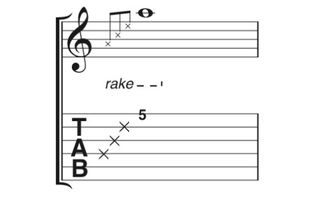
Drag the pick across the strings shown with a single sweep. This is often used to augment a rake’s last note.
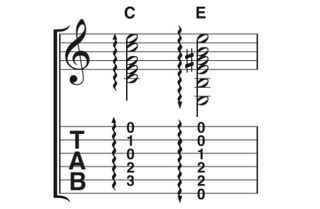
Play the notes of the chord by strumming across the relevant strings in the direction of the arrow head.
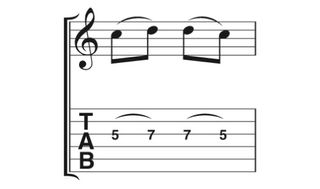
Pick the first note then hammer down on the string for the second note. Pick the third note and pull-off for the fourth note.
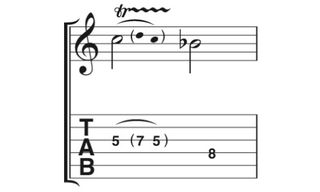
After picking the first note, rapidly alternate between the two notes shown in brackets using hammer-ons and pull-offs.

Pick the first note and then slide to the next. For the last two notes pick the first, slide to the next and then re-pick it (RP).
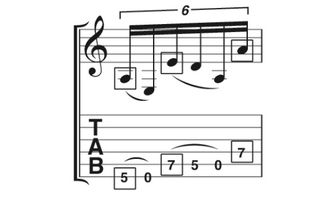
Sound the notes marked with a square by hammering-on/tapping with your fret-hand fingers, instead of picking.
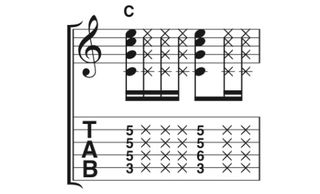
X markings represent notes and strings that are muted by your fret hand when struck by your picking hand.
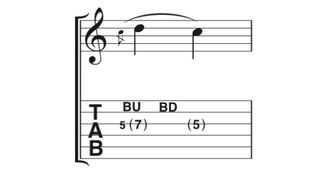
Fret the first note (here, the 5th fret) and bend up to the pitch of the bracketed note, before releasing again.
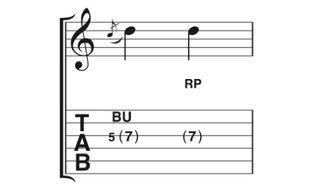
Bend up to the pitch shown in the brackets, then re-pick the note while holding the bent note at the pitch shown.
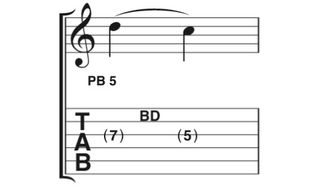
Silently bend the string up from the 5th fret (PB5) to the pitch of the 7th fret note, pick it and release to the 5th fret note.
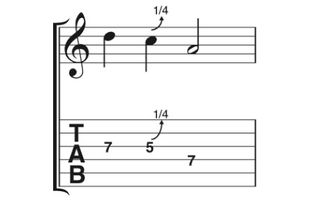
Pick the note then bend up a quarter-tone (a very small amount). This is sometimes referred to as a ‘blues curl’.
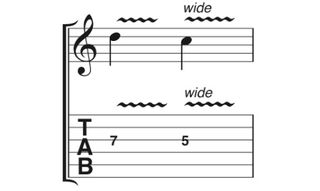
Your fretting hand vibrates the string by small bend-ups and releases. Exaggerate this effect to create a ‘wide’ vibrato.

Pick the note while lightly touching the string directly over the fret indicated. A chiming harmonic results.
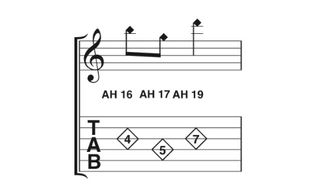
Fret the note as shown, then lightly place your index finger directly over ‘x’ fret (AH ‘x’) and pick (with a pick, p or a).
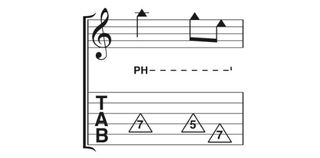
After fretting the note in the triangle, dig into the string with the side of your thumb as you sound it with the pick.

Place your finger on the note as shown, but sound it with a quick pick hand tap at the fret shown (TH17) for a harmonic.
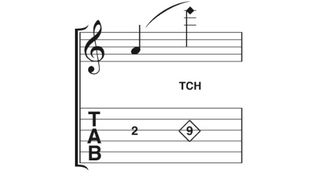
A previously sounded note is touched above the fret marked TCH (eg, TCH 9) for it to sound a harmonic.
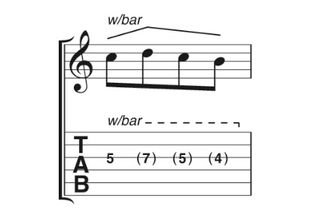
The note is picked as shown, then the vibrato bar is raised and lowered to the pitches shown in brackets.
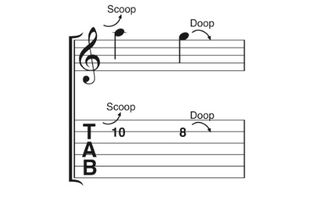
Scoop: depress the bar just before striking the note and release. Doop: lower the bar slightly after picking note.
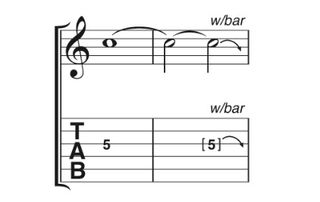
A note is sustained then the vibrato bar is depressed to slack. The square bracket indicates a further articulation.
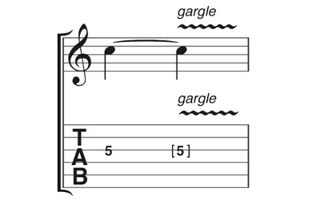
Sound the note and ‘flick’ the vibrato bar with your picking hand so it ‘quivers’. This results in a ‘gargling’ sound!
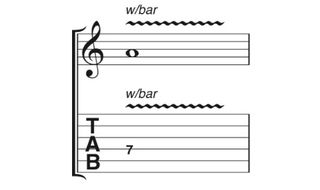
Gently rock the whammy bar to repeatedly bend the pitch up and down. This sounds similar to fret hand vibrato.
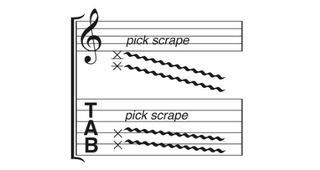
The edge of the pick is dragged either down or up along the lower strings to produce a scraped sound.

Turn the volume control down, sound the note(s) and then turn the volume up for a smooth fade in.
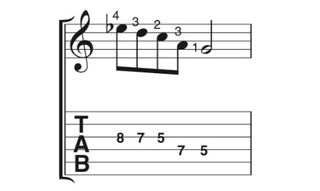
The numbers in the traditional notation refer to the fingers required to play each note.

Any kind of fingerpicking requirements are shown at the bottom of the tab notation.
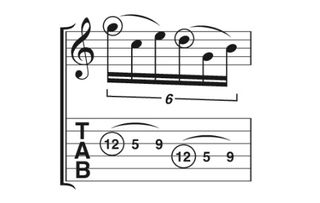
Tap (hammer-on) with a finger of your picking hand onto the fret marked with a circle. Usually with ‘i’ or ‘m’.
Now you've got the hang of reading tab, try learning a few open-position guitar chords.
MusicRadar is the number one website for music-makers of all kinds, be they guitarists, drummers, keyboard players, DJs or producers.
If you break through the top layer of the band's mega hits, you’ll find that a lot more goes into their chord progression than G, C, Em7 and D: Learn these unexpected Oasis guitar chords
“An inspiring opportunity to get inside the mind and skill set of the guitar world’s newest icon”: Matteo Mancuso shares all the secrets behind his breathtaking style in new Jam Track Central masterclass